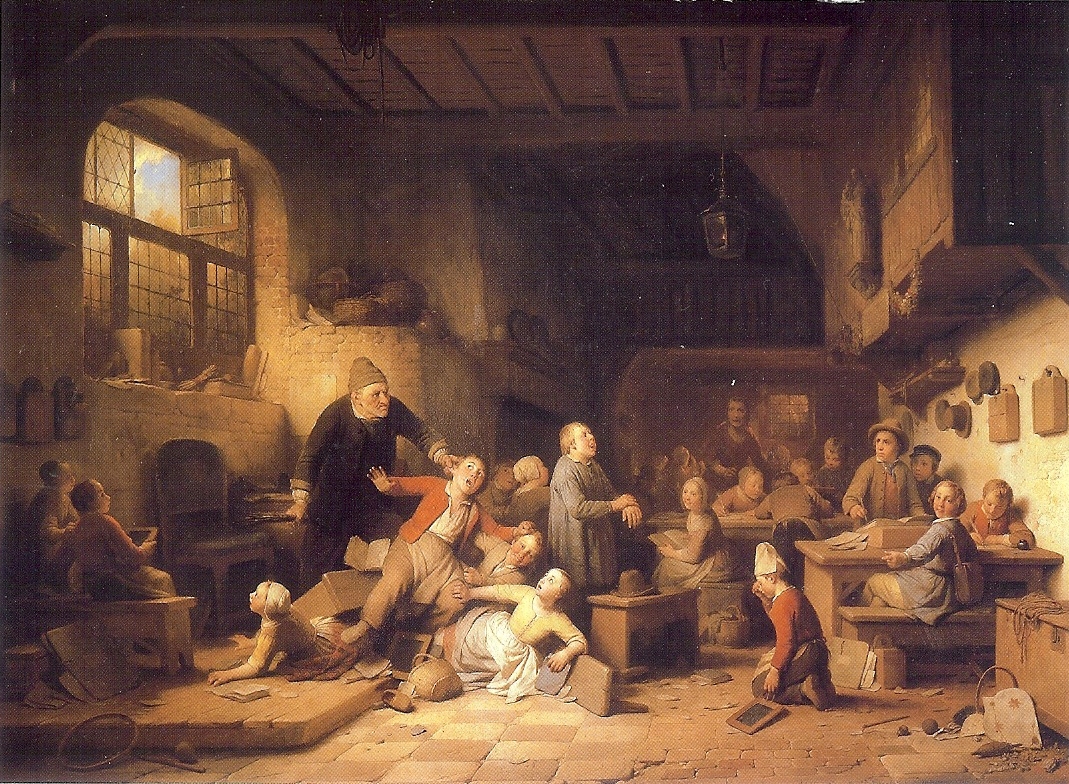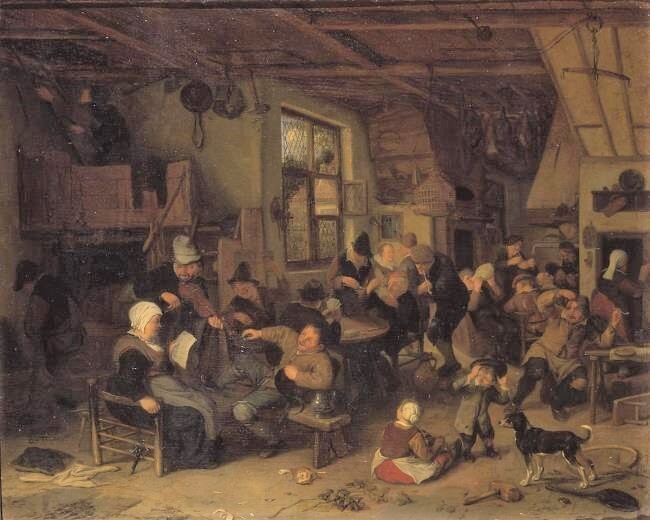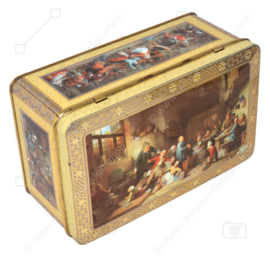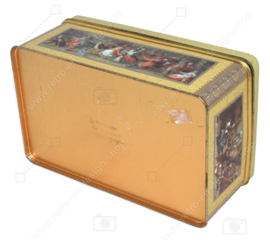SOLD
Vintage tin by DE GRUYTER with images of paintings by old masters
SKU: BT-3827-21SOLD
Vintage tin by DE GRUYTER with images of paintings by old masters
- Manufacturer: Dutch Vereenigde tin factory
- Manufacture date: 1950 - 1980
Description
Vintage tin for DE GRUYTER with images of paintings by old masters. This tin has a rectangular shape and is equipped with a hinged lid. The tin box is manufactured with a seamed longitudinal seam. The hinge is hinged hinges with loose tabs. The decoration of this tin consists of a gold-coloured background with decorations and an image of an old master painter on each side.
On the cover "The village school" by F. de Braeckeleer. Front and back "Dorpskermis" by David Vinckboons and on the short sides "Interior with farmers" by Cornelis Dusart.
Embossed on the bottom of the tin is the slogan: "And better wares And 10% Only De Gruyter".
Condition
This tin drum is in a good vintage condition with traces of use and age-related traces of wear. Photos are part of the description.
Dimensions
- Height: 8 cm.
- Length: 18.3 cm.
- Width: 11.2 cm.

Ferdinand de Braekeleer (Antwerp, 12 February 1792 – Antwerp, 16 May 1883), sometimes spelled as Ferdinand de Braeckeleer, was a Flemish painter. He is known for his historical paintings and is called 'the Elder' to distinguish him from his son with the same name (Ferdinand de Braekeleer the Younger), who was also a painter.
Ferdinand was born in a poor family. After his parents died he was admitted to the Art school for orphans of Mathieu Ignace van Brée in Antwerp. He continued his education at the Royal Academy for Fine Arts of Antwerp. His paintings received several prizes in 1809 and 1811. In 1813 he made his reputation at the Salon de Paris with his work Aeneas die Anchises redt uit de brand van Troje ("Aeneas saving Anchises from the fire of Troy").
Early on, De Braekeleer decided that he wanted to make a living as a painter and he tried out several genres to find out which one would most likely bring him most success. In addition to historical paintings, he also painted religious paintings, such as St. Sebastiaan for the Church of Our Lady of the Vineyard in Wijnegem (current location unknown).

David Vinckboons (baptized 13 August 1576 – c.1632 ) was a Dutch Golden Age painter born in Mechelen, Southern Netherlands. Vinckboons, whose name is often spelled as Vingboons, Vinghboons, Vinckebonis or Vinckboom, had at least ten children. His sons were the cartographer and watercolourist Johannes and the architects Justus and Philip. Vinckboons himself died in Amsterdam.
Vinckboons was one of the most prolific and popular painters and print designers in the Netherlands. Himself influenced by Pieter Bruegel the Elder, he was instrumental – together with Hans Bol and Roelant Savery – in the development of genre painting in the northern Netherlands.

Cornelis Dusart (Haarlem, April 24, 1660 – Haarlem, October 1, 1704) was a Dutch painter and engraver belonging to the Hollandse School. He was the son of composer, carillonneur and organist Joan Dusart.
Dusart was admitted to the Haarlem Guild of Saint Luke in 1679. He was a faithful follower of Adriaen van Ostade. He managed to approach his famous example in quality so closely that some of Dusart's works, for example, Farmers for an inn in the Belvedere Palace in Vienna, were formerly mistaken for that of Van Ostade. His engravings are also in the vein of Van Ostade.
De Gruyter was a retail chain in the Netherlands, in the 19th century and 20th century (until 1976). At its peak, there were more than 550 stores and nearly 7,500 employees.
An important element in the sales policy was the giving of a 10% discount when handing in the receipts. The slogan of De Gruyter was, therefore: And better true and ten per cent, only De Gruyter. This rewarded loyal customers and provided an additional means of checking the branch managers. Because De Gruyter only sold products of its own brand, the gross prices could not be compared with those of others.
As a customer binder, De Gruyter gave away a small gift for children every week from 1948: the legendary Candy of the week. It was introduced when sugar went off the receipt after World War II and there was too much sugar on offer. With a few guilders worth of groceries, unsolicited candy was given to the children. Later the "candy" became a plastic toy, a game, a doll or a book. Something different every week. A long-lasting campaign was that of cardboard building boards for houses and buildings.
Some translations come from an automated system and may contain errors
Country of origin
The Netherlands - Holland
Kind of object
Vintage tin made by De Gruyter
Theme
De Gruyter - old masters - paintings - storage tin - biscuit tin
Decoration
The village school, F. de Braeckeleer - Village fair, David Vinckboons - Interior with farmers, Cornelis Dusart
Category
Vintage tins
Publisher
De Gruyter
Manufacturer
Nederlands Vereenigde blikfabriek
Brand
De Gruyter
Material
Tin - metal - paint
Particularities
Hinged Lid - Embossed Slogan at Bottom
Era
1950 - 1980
Quality
Good vintage condition
Height
8,00 cm
Lenght
18,30 cm
Width
11,20 cm
Shipping method
Parcel post with track & trace



























